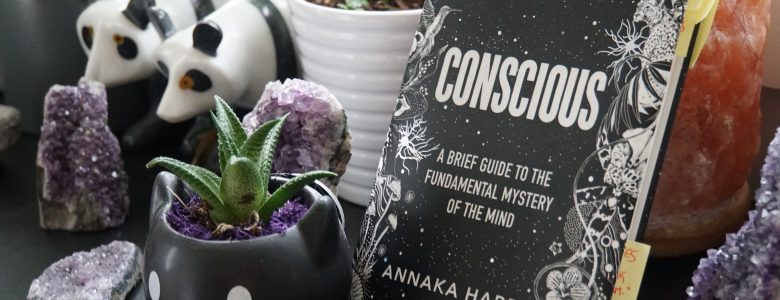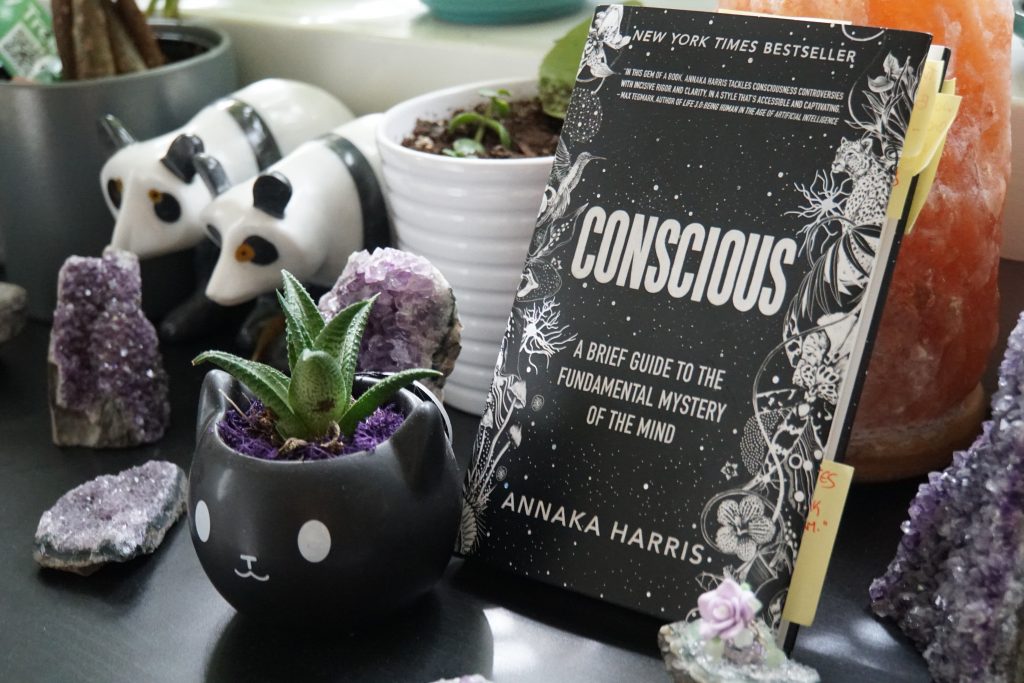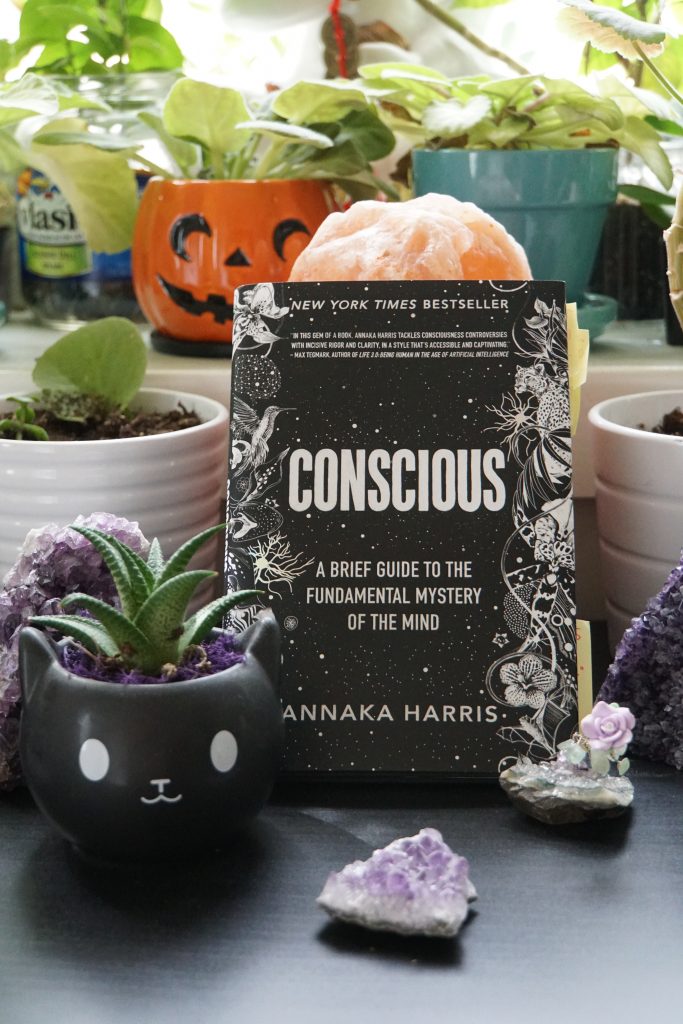March 11, 2020
Review: Conscious by Annaka Harris

By: burgundy bug
“Conscious: A Brief Guide to the Fundamental Mystery of the Mind by Annaka Harris” displayed among plants and crystals
Source: Conscious: A Brief Guide to the Fundamental Mystery of the Mind by Annaka Harris | Penelope Peru Photography
Using neuroscience, psychology, and philosophy as her compass, Annaka Harris guides the reader through the mystery of consciousness in “Conscious: A Brief Guide to the Fundamental Mystery of the Mind.”
Keeping the journey short, sweet, and digestible, Harris manages to present the big question in just a little over 100 pages – an impressive feat, considering the debate has spanned over multiple centuries.
WARNING: The top half of this review contains spoilers.
Click here to skip the spoilers.
Note: This post contains affiliate links.
“I remember looking up at the sky when I was young and realizing that my usual sense of being down on the ground with the sky above me wasn’t an entirely accurate perception,” Harris explains at the beginning of the book. “I was intrigued by the fact that even though I had learned that gravity pulls us toward the earth as we orbit the sun – and that there is no real ‘up’ and ‘down’ – my feeling of being down on the ground below the sky had remained unchanged.”
“To shift my perspective, I would sometimes lie outside with my arms and legs outstretched and take in as much of the sky and the horizon as possible. Attempting to break free of the familiar feeling of being down here with the moon and the stars above me.”
– Annaka Harris in “Conscious: A Brief Guide to the Fundamental Mystery of the Mind”
“Conscious” starts at the central question of why we’re conscious in the first place and uses American philosopher Thomas Nagel’s explanation of consciousness to define the term:
“An organism is conscious if there is something that it is like to be that organism”
– Thomas Nagel
Then, Harris prefaces the mystery with two questions intrinsic to solving it:
“1. In a system that we know has conscious experiences – the human brain – what evidence of consciousness can we detect from the outside?
2. Is consciousness essential to our behavior?”
Annaka Harris in “Conscious: A Brief Guide to the Fundamental Mystery of the Mind”
“Conscious: A Brief Guide to the Fundamental Mystery of the Mind” may not answer where consciousness comes from, but the arguments presented throughout the book will – quite literally – change your mind.
Chapter three, “Is Consciousness Free,” uses various case studies to illustrate an especially striking idea: that consciousness doesn’t create our will, rather, it’s merely a device for interpreting internal and external behavior.
Harris supports this idea through research that demonstrates how the “illusion of will” can be “intentionally triggered and manipulated.”
“Experimenters have been able to cause a feeling of will in subjects when the subjects in fact had no control,” she writes. “It seems that, under the right conditions, it’s possible to convince people that they have consciously initiated an action that was actually controlled by someone else.”
Other intriguing discussions throughout the book include: bacterial infections that alter consciousness, the role of psychedelics in researching consciousness, and a modern approach to panpsychism – the idea that consciousness is “perhaps embedded in matter itself, as a fundamental property of the universe.”
Additionally, Harris tears down the idea of consciousness itself being an “illusion,” elegantly persuading the reader to agree consciousness is one of the few undeniable parts of life.
The book draws to a close with an exploration of how the mind perceives time, approaching it from two different angles:
“1. Presentism: Time is in fact flowing and only the present moment is ‘real’; or
2. Eternalism: We live in a ‘block universe,’ where time is more like space – just because you are in one location (or moment) doen’t mean the others don’t exist simultaneously.”
Annaka Harris in “Conscious: A Brief Guide to the Fundamental Mystery of the Mind”
The final chapter is again backed with scientific research but is certainly a lot to contemplate in just seven pages.
At the very end of the book, Harris concludes that it’s unlikely we’ll have a true understanding of consciousness, but leaves the “absolute boundaries of knowledge” subject to challenge.
“Humanity is young, and we’ve barely begun to understand our place in the cosmos. As we continue to look out from our planet and contemplate the nature of reality, we should remember that there is a mystery right here where we stand.”
– Annaka Harris in “Conscious: A Brief Guide to the Fundamental Mystery of the Mind”
Bug’s Two Cents
4.8 out of 5 conscious minds
“Conscious: A Brief Guide to the Fundamental Mystery of the Mind by Annaka Harris” displayed among plants and crystals
Source: Conscious: A Brief Guide to the Fundamental Mystery of the Mind by Annaka Harris | Penelope Peru Photography
First and foremost, I’m in awe of Harris’ ability to cover some of the biggest debates surrounding consciousness in a way that’s easy to understand for the average person and incredibly intriguing, as well.
Each chapter has a hypnotizing flow to it and fluidly transitions into the next topic of discussion, the language is comprehendible, and the entire book is a very unique combination of perspectives on the big question.
I immediately found myself enamored with “Conscious: A Brief Guide to the Mystery of the Mind.” Not only as a mad-scientist cloaked as a journalist or as an individual who’s studied psychology and philosophy throughout college, but as a conscious human being.
The only fault I can find with this book is the end feels a bit abrupt – and maybe I’m biased because I wasn’t ready for it to end. After all, I became quite attached to it within the seven days that I sped-read through “Conscious.”
I wasn’t necessarily expecting Harris to solve the mystery, especially in just 110-pages, but I wasn’t expecting her to entirely rewrite my perspective of consciousness in the way that she did, either.
The idea of consciousness as a passenger to our experiences rather than the driver is still just sinking in with me, and it’s been nearly two weeks since I turned over the final pages.
Furthermore, the book indirectly revives the idea of “dualism” with its “I think therefore I am” approach to prooving consciousness, yet it never once mentions René Descartes.
I’m sure Descartes would be smiling from his grave in Saint-Germain-des-Prés Church in Paris, France – or maybe his brain in Musée del’l Homme would light up – if he could only read how Harris proves the existence of consciousness.
(Apparently, Descartes’ brain is preserved separate from his body. There was even a neuroanatomical study published on it in 2017 – who knew!)
I also appreciated that Harris cited one of my favorite books, “How to Change Your Mind: What the New Science of Psychedelics Teaches Us About Consciousness, Dying, Addiction, Depression, and Transcendence” by Michael Pollan, during the discussion on psychedelics.
Overall, “Conscious: A Brief Guide to the Fundamental Mystery of the Mind” is a wonderfully insightful, breezy-read through one of mankind’s heaviest debates.
If you’re a conscious human being – which, you presumably are if you’re reading this review – I HIGHLY recommend picking this book up.
Interested in having content featured in an upcoming blog post or issue of The Burgundy Zine? Head on over to the submissions page!
For all other inquiries, please fulfill a contact form.



